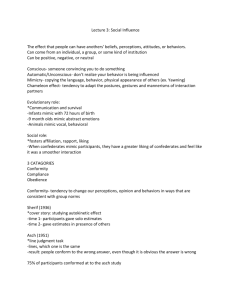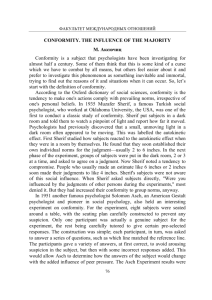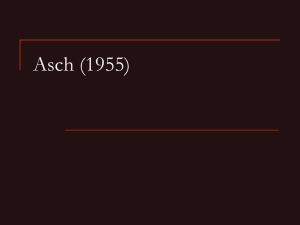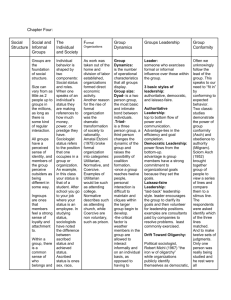No need to fake it: Reproduction of the Asch experiment without
advertisement
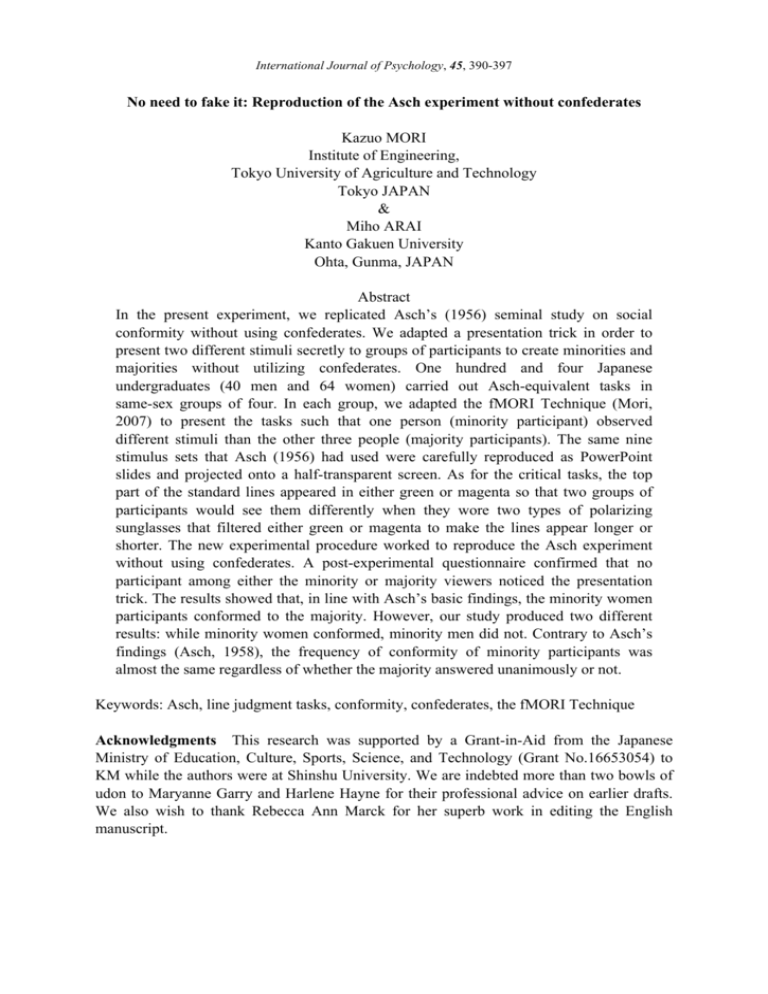
International Journal of Psychology, 45, 390-397 No need to fake it: Reproduction of the Asch experiment without confederates Kazuo MORI Institute of Engineering, Tokyo University of Agriculture and Technology Tokyo JAPAN & Miho ARAI Kanto Gakuen University Ohta, Gunma, JAPAN Abstract In the present experiment, we replicated Asch’s (1956) seminal study on social conformity without using confederates. We adapted a presentation trick in order to present two different stimuli secretly to groups of participants to create minorities and majorities without utilizing confederates. One hundred and four Japanese undergraduates (40 men and 64 women) carried out Asch-equivalent tasks in same-sex groups of four. In each group, we adapted the fMORI Technique (Mori, 2007) to present the tasks such that one person (minority participant) observed different stimuli than the other three people (majority participants). The same nine stimulus sets that Asch (1956) had used were carefully reproduced as PowerPoint slides and projected onto a half-transparent screen. As for the critical tasks, the top part of the standard lines appeared in either green or magenta so that two groups of participants would see them differently when they wore two types of polarizing sunglasses that filtered either green or magenta to make the lines appear longer or shorter. The new experimental procedure worked to reproduce the Asch experiment without using confederates. A post-experimental questionnaire confirmed that no participant among either the minority or majority viewers noticed the presentation trick. The results showed that, in line with Asch’s basic findings, the minority women participants conformed to the majority. However, our study produced two different results: while minority women conformed, minority men did not. Contrary to Asch’s findings (Asch, 1958), the frequency of conformity of minority participants was almost the same regardless of whether the majority answered unanimously or not. Keywords: Asch, line judgment tasks, conformity, confederates, the fMORI Technique Acknowledgments This research was supported by a Grant-in-Aid from the Japanese Ministry of Education, Culture, Sports, Science, and Technology (Grant No.16653054) to KM while the authors were at Shinshu University. We are indebted more than two bowls of udon to Maryanne Garry and Harlene Hayne for their professional advice on earlier drafts. We also wish to thank Rebecca Ann Marck for her superb work in editing the English manuscript. THE ASCH EXPERIMENT WITHOUT USING CONFEDERATES In one of psychology’s classic studies, Asch (1955; 1956; 1958) showed that individuals sometimes conformed to the responses of a unanimous majority even when the majority seemed to have made a wrong choice. In these studies, Asch asked a group of people to make a simple visual discrimination. Most of the group comprised confederates, who had been instructed to respond incorrectly and unanimously on several trials; the odd person out was the participant. Asch found that about 30% of participants conformed to the majority even though they knew the majority was incorrect. He also found that conformity was strongest when the majority had made a unanimous decision. These findings have been replicated using a number of different manipulations (see Bond and Smith, 1996, for review), but have always relied on confederates to present the majority view. Although confederates often play an important role in psychological science, using them has certain drawbacks. One intrinsic problem with using confederates is that they behave in a manner that is somewhat unnatural and artificial. Even well-trained confederates often violate the norms for social interaction by engaging in stilted conversations and raising participants’ suspicions about the real purpose of the experiment. In fact, following the publication of Asch’s original experiment, Crutchfield (1955) raised the problem of using confederates in research on social conformity and he developed an alternative conformity procedure in which each participant sat separately in a cubicle. The experimenter then fed participants information that presumably came from the other participants. Although the Crutchfield paradigm gets around the problem of using confederates, it eliminates face-to-face interaction between participants that may have important effects on conformity. The Asch conformity experiments have been repeated with a variety of independent variables (culture, sex, response conditions, etc.) for more than a half of century (Bond and Smith, 1996), but even from the beginning there were criticisms about the procedure. Stricker, Messick, and Jackson (1967) reported that many participants were suspicious of the purpose of the Asch experimental procedure. More recently, Hodges and Geyer (2006) quoted an anecdote reported in Asch (1951) that a participant who always dissented “announced” all disagreeing answers in the form of “Three, sir,” but did not do so when everyone gave the correct answer. There were some negative findings of conformity itself. For example, Allen and Levine (1969) reported counter evidence of the well-known unanimity effect of conformity. Perrin and Spencer (1981) reported that there was no conformity found in their replication of the Asch experiment. Standing and Lalancette (1990) found that even with a more ambiguous task, thus in a more conformity-inducing condition, no conformity was observed in the Asch experiment. Whether the observed conformity in the Asch experiments was really conformity to the group or not has also been challenged by many scholars (See a review by Hodges and Geyer, 2006). Schulman (1967) compared the effects of the experimenter and the group using a factorial experimental design and found that the performance of the participants was affected not only by the group but also by the presence of the experimenter. The participants tended to answer taking into account the assumed expectations of the experimenter. Although the Asch conformity experiments have been regarded as well-established 2 THE ASCH EXPERIMENT WITHOUT USING CONFEDERATES studies on the conformity of minority to majority, the experimental findings have been somewhat inconsistent across studies. There have been many follow-up studies that found conformity under various conditions as reviewed in Bond and Smith (1996), while there have been contradictory studies that found no conformity at all. One possible source of this inconsistency might be related to the use of confederates. While well-trained and highly motivated confederates might behave in such a way as to increase conformity, less well-trained or less motivated confederates might decrease conformity. Complicating matters even further, there may be individual differences in participants’ ability to detect the presence of confederates. For example, Walker and Andrade (1996) conducted the Asch (1956) conformity tasks with five age groups of children (3-5, 6-8, 9-11, 12-14, and 15-17 years old) to examine the development of conformity. They used pre-trained confederates chosen from the same classroom as the participants. They found that younger participants were more likely to conform. Although they interpreted these results as evidence that conformity decreases with age, it is equally possible that older children were more likely than younger children to detect the presence of confederates. In order to properly examine the effects of majority decision on conformity, it would be ideal to have a procedure that did not require the use of confederates. Here, we report the results of new procedure that can be used to study social conformity but that does not rely on the use of confederates. In 2003, Mori developed a new technique that allows researchers to study a wide range of social conformity phenomena without using confederates. The MORI Technique (Manipulation of Overlapping Rivalrous Images by polarizing filters), allows experimenters to present two different movies simultaneously to two groups of viewers, who remain unaware of the duality. The technique was originally developed to examine how discussion among potential witnesses might alter their subsequent report of an event (Garry, French, Kinzett, & Mori, 2008; Kanematsu, Mori, & Mori, 2003; Mori & Mori, 2008), but there is no reason that the MORI technique must be limited to the study of eyewitness memory. It could also be used to examine how discrepancies influence a myriad of behaviors—behaviors such as those that Asch studied. In fact, Mori and Mori (2008) found that minority witnesses tended to conform to the reports of other co-witnesses. Thus, the MORI technique has the potential to reproduce the same experimental situation as Asch but without using confederates. In the present study, we attempted to replicate the original Asch experiment using the fMORI Technique (Mori, 2007), which is a variation of the MORI Technique suitable for presenting two different static visual stimuli in a more precise manner. Our goal was to determine whether we could obtain social conformity without the use of confederates. If we produced results similar to those of Asch without relying on confederates, it would mean that the criticism against the Asch studies should not have stemmed from the experimental procedure of using confederates. However, if a different finding were obtained from this ecologically valid experimental paradigm without using confederates, we would need to reexamine the well-established findings about how people behave under social pressure. 3 THE ASCH EXPERIMENT WITHOUT USING CONFEDERATES Method Participants. One hundred and four undergraduates (40 men and 64 women) participated in same-sex groups of four. All of them had normal or corrected-to-normal vision. Note that in Asch (1956), only men participated. To allow us to examine possible gender differences, we also included women in our sample. Experimental design. The study was a 2 (role: minority vs. majority) x 2 (sex: men, women) between-subjects factorial design. The procedural variables (types of sunglasses used by minority and order of tasks) were fully counterbalanced among participants. The dependent variable was the frequency of errors on the 12 critical tasks for each participant. Stimuli. We used Adobe Photoshop to recreate the same nine stimulus sets that Asch (1956) had used. In Asch (1956), the standard line was drawn in black on a white card and the three comparison lines were drawn on another card. The two cards were shown 40 inches (about 1 m) apart. In the present experiment, our standard and comparison lines appeared on the same screen about 1 m apart. The standard line appeared on the left of the screen and was 5.08 to 25.40 cm (2 to 10 inches) long, or the same length as on the cards used in Asch (1956). The three comparison lines were also replicated in the same length as those of Asch (1956). They were of various lengths, one being the same length as the standard and the other two approximately one inch longer or shorter. Three of the nine stimulus sets were used for the neutral trials; in these trials, there was no difference in the stimuli that were presented to the minority and majority viewers. These neutral sets corresponded to the tasks in the Asch experiments in which the confederates answered correctly. The remaining six sets were used in the critical tasks in which the minority viewer would see the standard lines differently from the other three majority viewers. In these trials, the top part of the standard lines appeared in either green or magenta so that two groups of participants would see them differently when they were projected with the fMORI Technique. Two different series of stimuli were prepared so that a minority viewer could be created with either the green-passing or the magenta-passing sunglasses. Fig.1. Stimulus used for Task #7: The top green part of the standard line can be seen either in black with the magenta-light-passing sunglasses or in green to blend into the background with the green-light-passing sunglasses. 4 THE ASCH EXPERIMENT WITHOUT USING CONFEDERATES Apparatus. The stimuli were presented on PowerPoint slides with a personal computer (Apple iBook) and projected by an LCD projector (EPSON ELP-730) onto a rear screen. The screen was made from an office partition 183 cm in height and 146 cm in width by changing the window glass pane from patterned to plain ground glass (80 cm x 142 cm). The rear screen was set 2.35 m away from the projector. Four chairs were placed two abreast in two rows about 2 m apart on the other side of the screen. Four pairs of polarizing sunglasses were used. They looked identical to the naked eye, but in reality there were two different sets of glasses that differed in terms of the direction of polarization. Three pairs were used by those in the majority and one pair was used by the minority viewer. A pair of sunglasses was placed on each chair before the participants entered the laboratory. The minority participant’s sunglasses were placed on the third chair. Questionnaire. Asch (1956) conducted an interview with participants after the tasks. Instead of conducting interviews, we constructed a questionnaire containing 22 questions extracted from the contents of the interview in Asch (1956). Among these questions, respondents were asked whether they had noticed any anomaly in the images, whether they had found any visual illusions during the tasks, whether they had noticed the presence of others who answered differently, whether they were confident of their judgments, and whether they had tended to rely on the answers of others when they were not confident of their own judgments. (The interview questionnaire is available from the author on request.) Procedure. Participants were invited into the laboratory and were asked to take a seat in one of four chairs, each with a pair of sunglasses on it. Participants were instructed to pick up the sunglasses and be seated. After that, the experimenter gave the same general instructions as Asch (1956) did: This is a task involving the discrimination of lengths of lines. In front of you is a screen. On the left of the screen there will be one line, and on the right there will be three lines differing in length; they are numbered 1, 2, and 3, in order. One of the three lines at the right is equal to the standard line at the left. You will decide in each case which is the equal length line. You will state your judgment in terms of the number of the line. There will be 18 comparisons in all. As the number of comparisons is few and the group small, I will call upon each of you in turn to announce your judgments, which I will record here on a prepared form. Since your seat order was determined by draw before entering the laboratory, you will give your answer in the seat order, from # 1 to #4. Then, the experimenter double-checked whether they all knew their answering order by asking them to reply in that order. Finally, the experimenter instructed them to pay special attention to the following three points: 1) Please be accurate as possible. You don’t have to answer in haste. 2) Please make the judgment by yourself. 3) Please do not talk with or react to the other participants and stay quiet unless it is your turn to answer. After all the instructions were given, the experimenter told participants to put on the sunglasses to protect their eyes from glare. Then, the experimenter presented the line 5 THE ASCH EXPERIMENT WITHOUT USING CONFEDERATES judgment trials to the participants in the predetermined order. Each trial took approximately 30 seconds. Consistent with Asch (1956), each group completed 18 trials; that is, each of the nine stimulus sets was presented twice. Of these, six trials were neutral in which all viewers saw the same thing. In the remaining 12 trials, the minority and majority participants each saw something different. After the line judgment task was completed, participants answered the questionnaire and were then debriefed before leaving the laboratory. Results Before we address our primary research question, the first question we must address is did the manipulation work? The answer is yes. The three participants wearing the same type of sunglasses answered correctly on 859 out of 936 tasks (78 participants x 12 tasks), or 91.8 % of the time, while the other participant with a different type of sunglasses identified a different line as the correct one on 251 out of 312 tasks (26 participants x 12 tasks), or 80.4 % of the time. Their response pattern clearly showed that a majority was created consisting of three who responded in the same way and a minority of one who answered differently from the other three. Thus, majority and minority viewers were produced among naïve participants without introducing confederates. Both the behavior of the participants during the sessions and their answers to the subsequent questionnaire revealed that practically all the participants had noticed the conflict. Those participants in the majority groups noticed the minority opinion (only one male participant out of 30 left this question blank), and all of them in the minority condition noticed that their judgments seemed different from the others. Despite this awareness, no one detected the presentation trick. More to the point, nobody reported any suspicion about the method. Taken together, these findings suggest that our manipulation was effective. Although it was a Fig.2. Average number of errors in response order (Max. = 12; Vertical lines represent standard deviations.): The third responders were the minority participants. The women third responders (n = 16) showed a marked tendency to conform, while their male counterparts (n = 10) did not. 6 subjective observation by the experimenter, all the participants behaved naturally and honestly even though there were conflicts among them. We were concerned that the majority participants might laugh at the THE ASCH EXPERIMENT WITHOUT USING CONFEDERATES Table 1 Number of minority participants in terms of error frequencies on critical trials. ------------------------------------------------------------------------------------------------Number of errors Men (N = 10) Women (N = 16) Asch (1956) (N = 123) ------------------------------------------------------------------------------------------------0 7 3 29 1 1 2 8 2 1 3 10 3 1 3 17 4 0 0 6 5 0 1 7 6 0 1 7 7 0 0 4 8 0 1 13 9 0 1 6 10 0 1 6 11 0 0 4 12 0 0 6 ---------------------------------------------------------------------------------------------------Total number of errors 6 55 542 Average number of errors .6 3.44 4.41 Median number of errors 0 2.5 3 “awkward” responses of the minority. However, everyone engaged the tasks seriously and no one made fun of the responses of the others. We now turn to our primary question: Did the MORI Technique cause people to conform to the majority? Unlike the conventional Asch experiments, people in the majority condition in our experiment were not confederates; rather, they were also participants. Therefore, the majority participants who reported second and last might have conformed to the preceding respondents. To address this question, we examined the average number of errors of the participants by order of response. (See Fig. 2: The 3rd responders were the minority. The majority consisted of the 1st, 2nd, and 4th responders.) The response-order analysis revealed clear sex differences. As for the women, the third responders who wore the different type of polarizing sunglasses made errors three times more often (3.4 of 12 tasks; 28.6%) than the other three who performed in a similar way irrespective to the response order (1.1, 1.1, and 0.8, for 1st, 2nd, and 4th responders, respectively). The results clearly showed that the minority women erred more because they conformed to the majority (The distribution of errors in terms of the response order, Chi-square (3) = 52.239, p<.01). On the contrary, among the men, only the first responders made statistically more errors (1.6 of 12 tasks; 13.3%) than the other three (Chi-square (3) = 9.215, p<.05). The error rates were very low among the three respondents (0.5, 0.6, and 0.8, for 2nd, 3rd, and 4th responders, respectively) irrespective of the experimental groupings, 7 THE ASCH EXPERIMENT WITHOUT USING CONFEDERATES majority or minority. Those participants seemed to perform more cautiously, making no more errors than the first responders. The next step in our analysis was to compare the error rates of the minority participants with the corresponding data in Asch (1956; see Table 1.) The pattern of errors for the woman participants was similar to that of Asch (1956). For both sets of data, some participants made no errors, and the number of errors varied over a wide range. In other words, the errors were not made by particular participants who erred on almost all of the tasks. The average numbers of errors were similar, 3.44 for the present study’s woman participants and 4.41 for the Asch participants, as were the medians, 2.5 and 3.0, respectively. However, the men’s data are quite different from those of the Asch study. This is noteworthy because all of the participants in the Asch experiments were men. Discussion Considered as a whole, our results show a pattern of conformity consistent with those of Asch—even without relying on confederates. However, our study also produced two different results: there was no conformity among minority men, and the conformity frequency was not affected when the majority did not respond unanimously. Why women conformed more than men is an interesting research question. Women tend to conform more frequently in the Asch literature (Bond and Smith, 1996). In addition, in our study minority men did not show any signs of conformity, although in the original Asch study only male participants were used and they conformed. There may be several potential explanations for our results. In the Japanese culture, boys may become more independent and less conforming along the development, while girls may remain conformable. However, it is recommended that more data be collected using this new experimental paradigm before speculating about the possible causes of gender differences. We have also identified one more important result. Contrary to the well-known findings (Asch, 1958), the frequency of conforming by the minority participants did not decrease even when the majority group did not respond unanimously. For example, because the majority viewers made a considerable number of errors (8.2%), there was sometimes no unanimous judgment among the majority. Therefore, we excluded all the data after anyone in the majority had made an error in order to obtain results equivalent to those in the original Asch experiments. There were 134 out of the total of 312 tasks (26 groups x 12 tasks) in which the majority group participants performed without error, just as the confederates in Asch (1956) had done. Similar errors among minority participants were found in the Asch-equivalent condition (25 out of 134 tasks, 18.7%) and in the overall condition (61 out of 312 tasks, 19.6%). These results showed that the frequency of conforming errors among the minority participants was almost the same even when the majority was not unanimous. What caused the differences between our findings and those of the Asch studies? Was the use or not-use of confederates the crucial cause of the differences? Before we draw that conclusion, we should discuss the other differences between the present study and the Asch studies. Was it due to cultural differences? Or perhaps that the tendency to conform has changed over time? Could it have been the presentation methods or interpersonal relations 8 THE ASCH EXPERIMENT WITHOUT USING CONFEDERATES that caused the differences? Our participants were Japanese undergraduates in the 21st century, while the participants in the Asch studies were undergraduates in the United States in the 1950s. A cultural difference between Japan and the US and/or a generational difference of more than half a century might have been possible causes of the differences between the two studies. However, as the review by Bond and Smith (1996) showed, conformity errors were reported across various cultures, including that of Japan. The tendency to conform was robust over time, too. Bond and Smith (1996) reviewed earlier studies from Asch (1951) to those in the 1990s and found similar ranges of conformity over 40 years. Therefore, cultural or generational differences are not a compelling explanation for the differing results between Asch’s findings and ours. Perhaps people conformed less in our study because the task was less difficult than Asch’s tasks. Although we tried to reproduce the original Asch tasks as much as possible, technical limitations for the fMORI Technique led us to change the background color from the plain white of the original Asch tasks to either magenta or green. In order to hide completely the other figure, random dot noises were added. Consequently, the task in our study became more difficult than in the original Asch studies, not less difficult: indeed, the error rates of the majority participants (8.2%) were much higher than those of the control condition in Asch (1956), which was less than 1%. It makes sense to assume that, if our tasks had been less difficult, conformity would have occurred less often. However, the participants conformed less in our study despite the fact that our tasks were more difficult than the original Asch ones. Finally, there was a crucial difference between the two studies in terms of interpersonal relationships between participants. In the Asch studies and all the other succeeding studies, the minority participants were not acquainted with the majority subjects, who were confederates in reality. As for the present study, the minority and majority participants were acquainted with each other. The majority as well as the minority participants were all naïve. These prior relationships might partly explain why we found less conformity than Asch. The value-pragmatics account by Hodges and Geyer (2006) predicted that conforming errors would be fewer among friends than among strangers. Whether the participants were acquainted with each other or not might have been the crucial factor that caused the experimental difference. If the difference in the experimental results between the Asch type studies and the present study stemmed from the interpersonal factor, we need to reconsider the findings of the original Asch studies. Conforming behavior among acquaintances is more important as a psychological research topic than conforming among strangers. Conformity generally takes place among acquainted persons, such as family members, friends, or colleagues, and in daily life we seldom experience a situation like the Asch experiment in which we make decisions among total strangers. It would be premature to make a final conclusion here. It should be noted that the new paradigm not only can reproduce the Asch experiment without using confederates, but it allows us to conduct experiments with confederates, as well. If we carried out the same experimental procedure but used only one type of polarizing sunglasses, all the participants 9 THE ASCH EXPERIMENT WITHOUT USING CONFEDERATES would observe the same stimuli. Even so, we can recreate the Asch experiment utilizing confederates by secretly asking some participants to choose the wrong answer on the critical tasks. In this way, we can examine authentically the effect of confederates by comparing the two conditions using the same experimental procedure with or without confederates. Although such authentic comparison experiments have not yet been conducted, we strongly recommend reconsideration of the findings obtained from previous experiments relying on confederates. The Asch study has become a legend, appearing in every social psychology textbook, and even distorted in various ways (Friend, Rafferty, & Bramel, 1990). The new experimental paradigm utilizing the fMORI Technique will provide a useful tool for reexamining the Asch conformity study in ecologically more appropriate conditions. The new experimental paradigm may also offer a useful means of examining conformity among participants in a variety of social relationships and of various ages, in which confederates could not have been used. One possible application might be in studies on the development of conformity within genuine peer groups of children in natural settings. References Allen, V. L. & Levine, J. M. (1969). Consensus and conformity. Journal of Experimental Social Psychology, 5, 389-399. Asch, S. E. (1951). Effects of group pressure on the modification and distortion of judgements. In H. Guetzknow (Ed.), Groups, leadership and men. Pittsburgh, PA: Carnegie Press. Pp. 177-190. Asch, S. E. (1955). Opinions and social pressure. Scientific American, 193, 33-35. Asch, S. E. (1956). Studies of independence and conformity: I. A minority of one against a unanimous majority. Psychological Monograph: General and Applied, 70, Whole No. 416. Asch, S. E. (1958). Effects of group pressure upon modification and distortion of judgments. In E. E. Maccoby, T. M. Newcomb, & E. L. Hartley (Eds.), Readings in social psychology (3rd ed.). New York: Holt, Rinehart & Winston. Pp. 174-183. Bond, R. & Smith, P. B. (1996). Culture and conformity: A meta-analysis of studies using Asch’s (1952b, 1956) line judgment task. Psychological Bulletin, 119, 111-137. Crutchfield, R.S. (1955). Conformity and character. American Psychologist, 10, 191-198. Friend, R., Rafferty, Y., & Bramel, D. (1990). A puzzling misinterpretation of the Asch ‘conformity’ study. European Journal of Social Psychology, 20, 29-44. Garry, M., French, L., Kinzett, T., & Mori, K. (2008). Eyewitness memory following discussion: Using the MORI Technique with a Western sample. Applied Cognitive Psychology, 112, 145-156. Hodges, B. H., & Geyer, A. (2006). A nonconformist account of the Asch experiments: Values, pragmatics, and moral dilemmas. Personality and Social Psychology Review, 10, 2-19. Kanematsu, H., Mori, K., & Mori, H. (2003). Memory distortion in eyewitness pairs who observed nonconforming events and discussed them. Journal of the Faculty of Education of Shinshu University, 109, 75-84. 10 THE ASCH EXPERIMENT WITHOUT USING CONFEDERATES Mori, K. (2003). Surreptitiously projecting different movies to two subsets of viewers. Behavior Research Methods, Instruments, and Computers, 35, 599-604. Mori, K. (2007). Projecting two words with one machine: A method for presenting two different visual stimuli using just one projector without viewer’ noticing the duality Behavior Research Methods, 39, 811-815. Mori, K., & Mori, H. (2008). Conformity among cowitnesses sharing same or different information about an event in experimental collaborative eyewitness testimony. Perceptual and Motor Skills, 87, 386-398. Perrin, S. & Spencer, C. P. (1981). Independence or conformity in the Asch experiment as a reflection of cultural and situational factors. British Journal of Social Psychology, 20, 205-209. Schulman, G. I. (1967). Asch conformity studies: conformity to the experimenter and-or to the group. Sociometry, 30, 26-40. Standing, L. G. & Lalancette, M.-F. (1990). Asch fails again. Social Behavior and Personality: An International Journal, 18, 7-12 Stricker, L. J., Messick, S., & Jackson, D. N. (1967). Suspicion of deception: Implications for conformity research. Journal of Personality and Social Psychology, 5, 379-389. Walker, M. B. & Andrade, M. G. (1996). Conformity in the Asch Task as a Function of Age, The Journal of Social Psychology, 136, 367-372. 11


